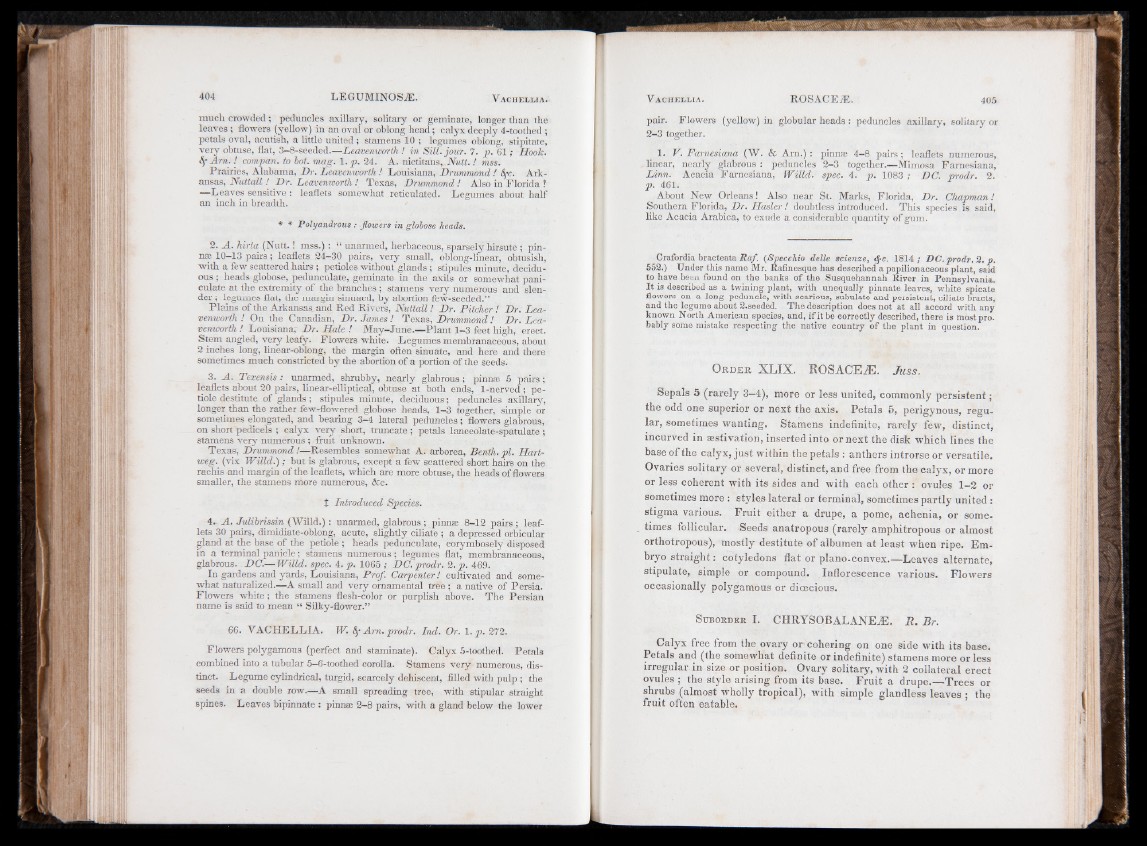
much crowded; peduncles axillary, solitary or geminate, longer than the
leaves ; flowers (yellow) in an oval or oblong head; calyx deeply 4-toothed ;
petals oval, acutish, a little united; stamens 10 ; legumes oblong, stipitate,
very obtuse, flat, 3-8-seeded.—Leavenworth ! in Sill. jour. 7. p. 61; Hook.
Sf Am . ! compan. to hot. mag. 1. p. 24. A. nietitans,.IVhff. ! mss.
Prairies, Alabama, Dr. Leavenworth ! Louisiana, Drummond ! 8fC. Arkansas,
Nuttall ! Dr. Leavenworth ! Texas, Drummond ! Also in Florida ?
—Leaves sensitive : leaflets somewhat reticulated. Legumes about half
an inch in breadth.
* * Polyandrous : flowers in globose heads.
2. A . hirta (Nutt.! mss.) : “ unarmed, herbaceous, sparsely hirsute ; pinnae
10—13 pairs; leaflets 24—30 pairs, very small, oblong-linear, obtusish,
with a few scattered hairs ; petioles without glands ; stipules minute, deciduous
; heads globose, pedunculate, geminate in the axils or somewhat paniculate
at the extremity of the branches ; stamens very numerous and slender
; legumes flat, the margin sinuaed, by abortion few-seeded.”
Plains of the Arkansas and Red Rivers, Nuttall! Dr. Pitcher ! Dr. Leavenworth
! On the Canadian, Dr. James ! Texas, Drummond ! Dr. Leavenworth
! Louisiana,' Dr. Hale ! May-June.—Plant 1-3 feet high, erect.
Stem angled, very leafy. Flowers white. Legumes-membranaceous, about
2 inches long, linear-oblong, the margin often sinuate, and here and there
sometimes much constricted by the abortion of a portion of the seeds.
3. A. Texensis: unarmed, shrubby, nearly glabrous; pinnas 5 pairs;
leaflets about 20 pairs, linear-elliptical, obtuse at both ends, 1-nerved ; petiole
destitute of glands ; stipules minute, deciduous; peduncles axillary,
longer than the rather few-flowered globose heads, 1-3 together, simple or
sometimes elongated, and bearing 3-4 lateral peduncles ; flowers glabrous,
on short pedicels ; calyx very short, truncate ; petals lanceolate-spatulate ;
stamens very numerous ; fruit unknown.
Texas, Drummond !—Resembles somewhat A. arborea, Benth. pi. Hart-
weg. (vix W illd .); but is glabrous, except a few scattered short hairs on the
rachis and margin of the leaflets, which are more obtuse, the heads of flowers
smaller, the stamens more numerous, <tec.
% Introduced Species.
4. A. Julibrissin (Willd.) : unarmed, glabrous; pinnae 8-12 pairs ; leaflets
30 pairs, dimidiate-oblong, acute, slightly ciliate ; a depressed orbicular
gland at the base of the petiole ; heads pedunculate, corymbosely disposed
in a terminal panicle; stamens numerous; legumes flat, membranaceous,
glabrous. DC.— Willd. spec. 4. p. 1065 ; DC. prodr. 2. p. 469.
In gardens and y'ards, Louisiana, Prof. Carpenter! cultivated and somewhat
naturalized.—A small and very ornamental tree ; a native of Persia.
Flowers white; the stamens flesh-color or purplish above. The Persian
name is said to mean “ Silky-flower.”
66. VACHELLIA. W. Am. prodr. Ind. Or. l .p . 272.
Flowers polygamous (perfect and staminate). Calyx 5-toothed. Petals
combined into a tubular 5—6-toothed corolla. Stamens very numerous, distinct.
Legume cylindrical, turgid, scarcely dehiscent, filled with pulp ; the
seeds in a double row.—A small spreading tree, with stipular straight
spines. Leaves bipinnate : pinnae 2-8 pairs, with a gland below the lower
pair. Flowers (yellow) in globular heads : peduncles axillary, solitary or
2-3 together.
1. V. Farnesiana (W. & Arn.) : pinnae 4-8 pairs; leaflets numerous,
linear, nearly glabrous : peduncles 2-3 together.—Mimosa Farnesiana,
Linn. Acacia Farnesiana, Willd. spec. 4. p. 1083 ; DC. prodr. 2.
p . 461.
About New Orleans! Also near St. Marks, Florida, Dr. Chapman!
Southern Florida, Dr. Hosier ! doubtless introduced. This species is said,
like Acafcia Arabica, to exude a considerable quantity of gum.
Crafordia bracteata Raf. (Specchio delle scienze, cf-c. 1814 ƒ DC. prodr. 2. p.
552.) Under this name Mr. Rafinesque has described a papilionaceous plant, said
to have been found on the banks of the Susquehannah River in Pennsylvania.
It is described as a twining plant, with unequally pinnate leaves, white spicate
flowers on a long peduncle, with scarious, subulate and persistent, ciliate bracts,
and the legume about 2.seeded. The description does not at all accord with any
known North American species, and, if it be correctly described, there is most pro.
bably some mistake respecting the native country of the plant in question.
Or d e r XLIX. ROSACEiE. Juss.
Sepals 5 (rarely 3-4), more or less united, commonly p e rsisten t;
the odd one superior or next the axis. Petals 5, perigynous, regular,
sometimes wanting. Stamens indefinite, rarely few, distinct,
incurved in aestivation, inserted into or next the disk which lines the
base of the calyx, just within the petals : anthers introrse or versatile.
Ovaries solitary or several, distinct, and free from the calyx, or more
or less coherent with its sides and with each other : ovules 1-2 or
sometimes more : styles lateral or terminal, sometimes partly united :
stigma various. Fruit either a drupe, a pome, achenia, or sometimes
follicular. Seeds anatropous (rarely amphitropous or almost
orthotropous), mostly destitute of albumen at least when ripe. Embryo
stra ig h t: cotyledons flat or plano-convex.—Leaves alternate,
stipulate, simple or compound. Inflorescence various. Flowers
occasionally polygamous or dioecious.
S u b o r d e r I. CHRYSOBALANEA3. R. Sr.
Calyx free from the ovary o r cohering on one side with its base.
Petals and (the somewhat definite or indefinite) stamens more or less
irregular in size or position. Ovary solitary, with 2 collateral erect
ovules ; the style arising from its base. Fru it a drupe.—Trees or
shrubs (almost wholly tropical), with simple glandless leaves ; the
fruit often eatable.